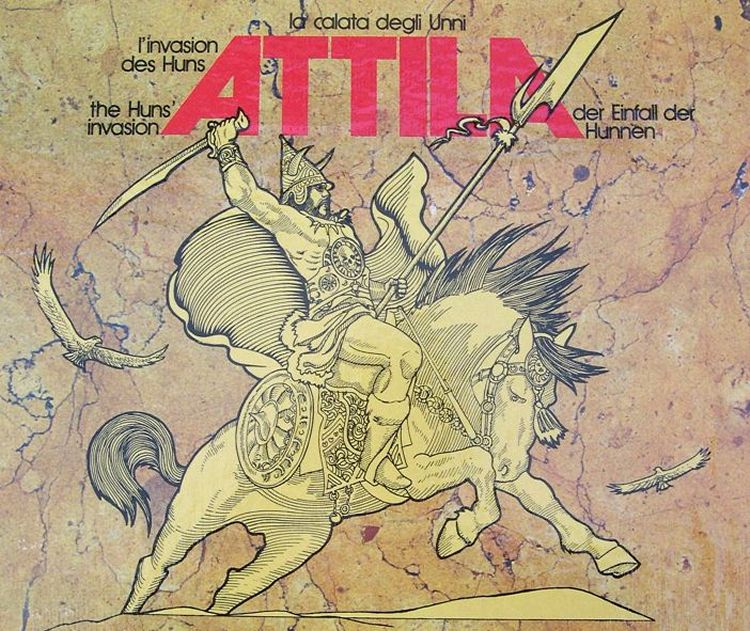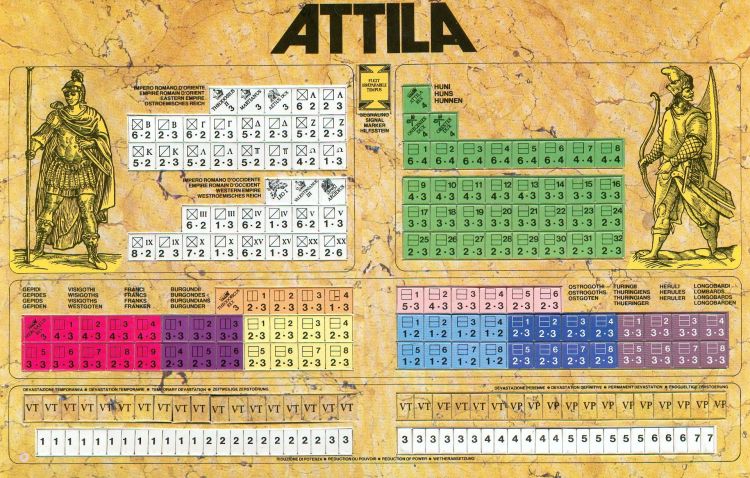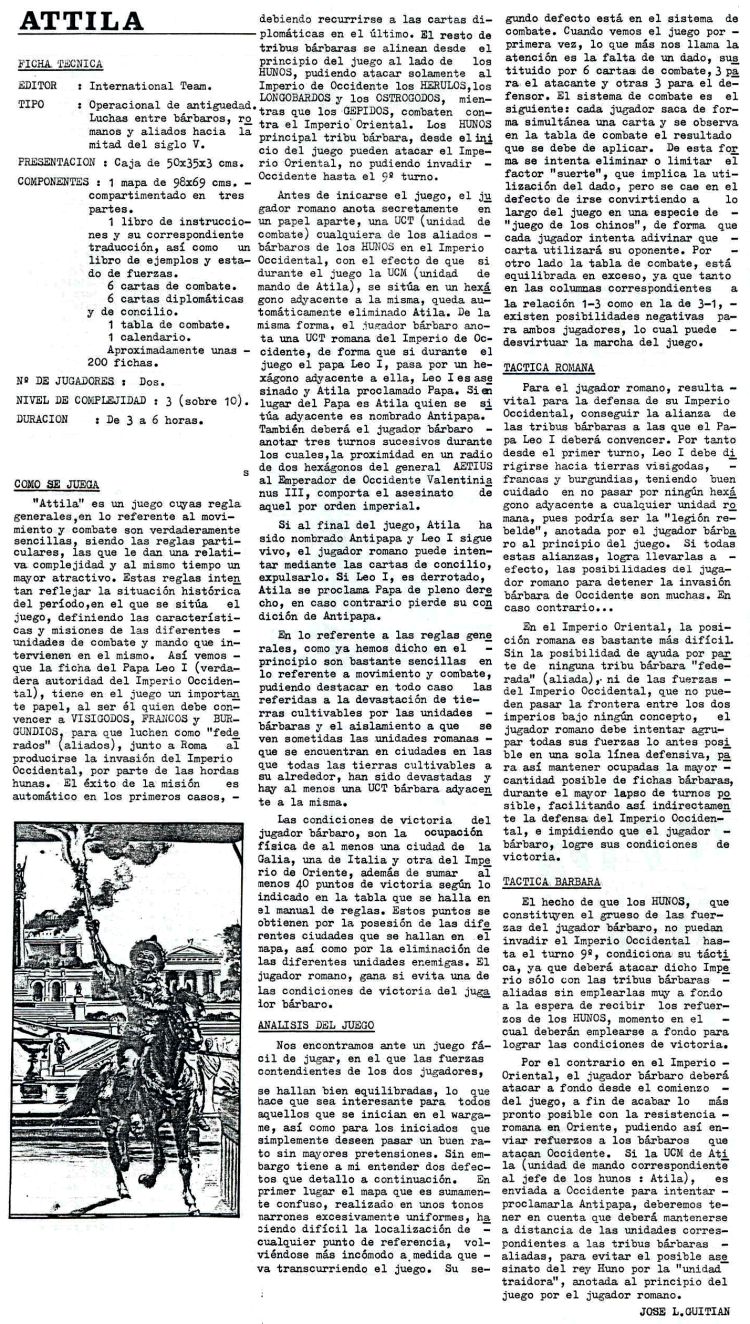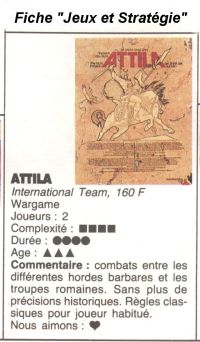

The game
Attila is a strategic wargame in Europe around year 450.
This is an uncommon game during an historical poorly known period. It was a period of ruins for roman cities. it was also a period where warriors people pillaged, settled and build kingdoms while becoming Christians. Attila was a barbarian warrior. But he was also an intelligent man, who spoke Latin and visited Constantionople palace when he was young. His declining army came to Rome doors. then Attila met Pope Leon 1st the great who convinced him not to pillage the city.
This game develop religious and diplomatic aspects, with barbarians people assimilated into Orient and occident Roman Empires. The pope travel to rally barbarians people (Visigoths, Franks and Burgundians). Attila can invade the Roman Empire and even become Pope.
The illustration
On a parchment background, we can see a beautiful monochrome draw of Attila riding his horse. The draw is not signed.

Opening of the box
The box contains the map, Romans and Barbarians counters, 6 playing cards to resolve combats, 1 combat table, the rules of the game, 1 calendar and 6 diplomatic playing cards.

The map
the map represents the Europe. the red lines represents frontiers of the Orient and Occident Roman Empires. To my mind, the map is missing colours to be best readable.

The counters
10 different colours are used to represent the Huns, the Romans and 8 Barbarians tribes. Some white counters are used to indicate a reduced value after combat. Some yellow counters are used to indicate agriculture zones devastated temporary or definitively. The counter on which Virgile is quoted "Fugit irreparabile tempus" (Irrecoverable time glides away) is of course used for the calendar.


The rules
The rulebook contains 17 pages in four languages (Italian, English, German, French).
 The object of the game for Attila is to occupy at least a city in the orient Roman Empire, one in Gaul,
one in Italy and occupy cities for a value of at least 20 points.
The object of the game for Attila is to occupy at least a city in the orient Roman Empire, one in Gaul,
one in Italy and occupy cities for a value of at least 20 points.Each turn is divided into 6 phases:
- Barbarian movement
- agriculture area devastations
- Barbarians attacks
 - power reduction on besieged roman units
- power reduction on besieged roman units- Romans movement
- Romans attacks
The diplomatic playing cards are used when pope Leo I enter in Lugdunum, to rally the Burgundians. It is also used in case of conflict between Leo I and the Attila to become Pope.
An article from Spain from the magazine "Maquetismo y Simulación" n°15

Some price (2004-2006):
| N° EBAY | Price EBAY | Country | Date | Remarks |
| 5917609417 | EUR 20 | France | 6 sept 2004 | |
| 5926818683 | EUR 41,50 | Italy | 21 oct 2004 | |
| 5951490640 | EUR 53 | Germany | 30 Jan 2005 | |
| 5953626001 | EUR 63 | Germany | 06 02 2005 | unpunched |
| 5189770823 | EUR 15,65 | Germany | 01 may 2005 | uncomplete |
| 5213024899 | EUR 32 | France | 03 July 2005 | |
| 5233773127 | $ 168,10 ! | Italy | 2 sept 2005 | |
| 5238757496 | $ 91 | USA | 15 sept 2005 | unpunched |
| 5290232084 | EUR 63 | Italy | 5 oct 2005 | |
| 8713465331 | EUR 55 | France | 26 oct 2005 | |
| 8711277019 | EUR 17,60 | France | 29 oct 2005 | |
| 8753629705 | EUR 15 | Italy | 25 jan 2006 | |
| 8755873080 | EUR 79 | Italy | 2 feb 2006 | |
| 8790279606 | EUR 76 | France | 11 apr 2006 | |
| 8794893869 | EUR 9,38 | Germany | 16 apvr 2006 | |
| 8811092919 | EUR 19,50 | France | 20 may 2006 | |
| 6060018030 | EUR 21,50 | France | 27 may 2006 |
 ATTILA overview
ATTILA overviewreference: W114
A game for 2 players from 15 years on
Time of Game: 4/8 hours
Degree of difficulty: 2 (quite easy)
Date: 1981 ?
Authors: International Team
Links:
Attila on boardgamegeek
Attila in LA CAVERNE
Attila on Tric-Trac
Another game on this period: Decline and Fall
A book ?
The classical "The history of the decline and fall of the roman empire" by Edward Gibbon
I am looking for:
- a copy of one article on Attila published in SIMULACRUM N° 11
Your comments on this page ?